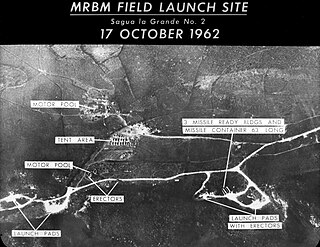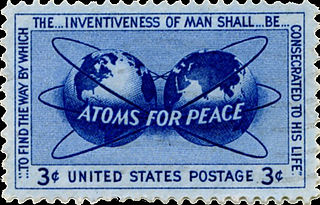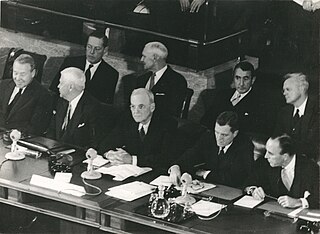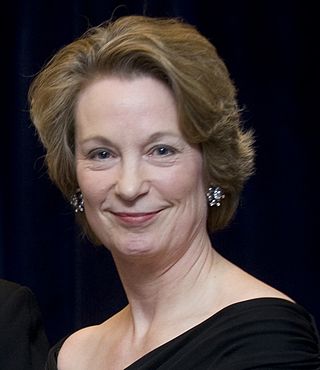
Dwight David Eisenhower, nicknamed Ike, was an American military officer and statesman who served as the 34th president of the United States from 1953 to 1961. During World War II, he was Supreme Commander of the Allied Expeditionary Force in Europe and achieved the five-star rank as General of the Army. Eisenhower planned and supervised two of the most consequential military campaigns of World War II: Operation Torch in the North Africa campaign in 1942–1943 and the invasion of Normandy in 1944.

Nikita Sergeyevich Khrushchev was First Secretary of the Communist Party of the Soviet Union from 1953 to 1964, and Chairman of the Council of Ministers (premier) from 1958 to 1964. During his rule, Khrushchev stunned the communist world with his denunciation of his predecessor Joseph Stalin's crimes and embarked on a policy of de-Stalinization with his key ally Anastas Mikoyan. He sponsored the early Soviet space program and the enactment of moderate reforms in domestic policy. After some false starts, and a narrowly avoided nuclear war over Cuba, he conducted successful negotiations with the United States to reduce Cold War tensions. In 1964, the Kremlin leadership stripped him of power, replacing him with Leonid Brezhnev as First Secretary and Alexei Kosygin as Premier.
The expression military–industrial complex (MIC) describes the relationship between a country's military and the defense industry that supplies it, seen together as a vested interest which influences public policy. A driving factor behind the relationship between the military and the defense-minded corporations is that both sides benefit—one side from obtaining weapons, and the other from being paid to supply them. The term is most often used in reference to the system behind the armed forces of the United States, where the relationship is most prevalent due to close links among defense contractors, the Pentagon, and politicians. The expression gained popularity after a warning of the relationship's detrimental effects, in the farewell address of U.S. President Dwight D. Eisenhower on January 17, 1961.

Brinkmanship or brinksmanship is the practice of trying to achieve an advantageous outcome by pushing dangerous events to the brink of active conflict. The maneuver of pushing a situation with the opponent to the brink succeeds by forcing the opponent to back down and make concessions rather than risk engaging in a conflict that would no longer be beneficial to either side. That might be achieved through diplomatic maneuvers, by creating the impression that one is willing to use extreme methods rather than concede. The tactic occurs in international politics, foreign policy, labor relations, contemporary military strategy, terrorism, and high-stakes litigation.

On 1 May 1960, a United States U-2 spy plane was shot down by the Soviet Air Defence Forces while conducting photographic aerial reconnaissance deep inside Soviet territory. Flown by American pilot Francis Gary Powers, the aircraft had taken off from Peshawar, Pakistan, and crashed near Sverdlovsk, after being hit by a surface-to-air missile. Powers parachuted to the ground and was captured.

The Cold War was a period of geopolitical tension between the United States and the Soviet Union and their respective allies, the Western Bloc and the Eastern Bloc, that started in 1947 after the end of World War II and lasted to 1991.

The Cold War (1953–1962) discusses the period within the Cold War from the end of the Korean War in 1953 to the Cuban Missile Crisis in 1962. Following the death of Joseph Stalin earlier in 1953, new leaders attempted to "de-Stalinize" the Soviet Union causing unrest in the Eastern Bloc and members of the Warsaw Pact. In spite of this there was a calming of international tensions, the evidence of which can be seen in the signing of the Austrian State Treaty reuniting Austria, and the Geneva Accords ending fighting in Indochina. However, this period of good happenings was only partial with an expensive arms race continuing during the period and a less alarming, but very expensive space race occurring between the two superpowers as well. The addition of African countries to the stage of cold war, such as the Democratic Republic of the Congo joining the Soviets, caused even more unrest in the West.

In macroeconomics, the guns versus butter model is an example of a simple production–possibility frontier. It demonstrates the relationship between a nation's investment in defense and civilian goods. The "guns or butter" model is used generally as a simplification of national spending as a part of GDP. This may be seen as an analogy for choices between defense and civilian spending in more complex economies. The nation will have to decide which balance of guns versus butter best fulfills its needs, with its choice being partly influenced by the military spending and military stance of potential opponents.

"Atoms for Peace" was the title of a speech delivered by U.S. President Dwight D. Eisenhower to the UN General Assembly in New York City on December 8, 1953.
I feel impelled to speak today in a language that in a sense is new—one which I, who have spent so much of my life in the military profession, would have preferred never to use. That new language is the language of atomic warfare.

The Geneva Summit of 1955 was a Cold War-era meeting in Geneva, Switzerland. Held on July 18, 1955, it was a meeting of "The Big Four": President Dwight D. Eisenhower of the United States, Prime Minister Anthony Eden of Britain, Premier Nikolai A. Bulganin of the Soviet Union, and Prime Minister Edgar Faure of France. They were accompanied by the foreign ministers of the four powers : John Foster Dulles, Harold Macmillan, Vyacheslav Molotov, and Antoine Pinay. Also in attendance was Nikita Khrushchev, de facto leader of the Soviet Union.

Dwight D. Eisenhower's tenure as the 34th president of the United States began with his first inauguration on January 20, 1953, and ended on January 20, 1961. Eisenhower, a Republican from Kansas, took office following his landslide victory over Democratic nominee Adlai Stevenson in the 1952 presidential election. Four years later, in the 1956 presidential election, he defeated Stevenson again, to win re-election in a larger landslide. Eisenhower was limited to two terms and was succeeded by Democrat John F. Kennedy, who won the 1960 presidential election.

Harry S. Truman's tenure as the 33rd president of the United States began on April 12, 1945, upon the death of president Franklin D. Roosevelt, and ended on January 20, 1953. He had been vice president for only 82 days when he succeeded to the presidency. Truman, a Democrat from Missouri, ran for and won a full four-year term in the 1948 presidential election, in which he narrowly defeated Republican nominee Thomas E. Dewey and Dixiecrat nominee Strom Thurmond. Although exempted from the newly ratified Twenty-second Amendment, Truman did not run for a second full term in the 1952 presidential election because of his low popularity. He was succeeded by Republican Dwight D. Eisenhower.

Susan Elaine Eisenhower is an American consultant, author, and expert on international security, space policy, energy, and relations between the Russian Federation and the United States of America. She is the daughter of John Eisenhower and the granddaughter of President Dwight D. Eisenhower.

During the Cold War, the Iron Curtain is a political metaphor used to describe the political boundary dividing Europe into two separate areas from the end of World War II in 1945 until the end of the Cold War in 1991. The term symbolizes the efforts by the Soviet Union (USSR) to block itself and its satellite states from open contact with the West, its allies and neutral states. On the east side of the Iron Curtain were the countries that were connected to or influenced by the Soviet Union, while on the west side were the countries that were NATO members, or connected to or influenced by the United States; or nominally neutral. Separate international economic and military alliances were developed on each side of the Iron Curtain. It later became a term for the 7,000-kilometre-long (4,300 mi) physical barrier of fences, walls, minefields, and watchtowers that divided the "east" and "west". The Berlin Wall was also part of this physical barrier.

Eisenhower's farewell address was the final public speech of Dwight D. Eisenhower as the 34th President of the United States, delivered in a television broadcast on January 17, 1961. Perhaps best known for advocating that the nation guard against the potential influence of the military–industrial complex, a term he is credited with coining, the speech also expressed concerns about planning for the future and the dangers of massive spending, especially deficit spending, the prospect of the domination of science through federal funding and, conversely, the domination of science-based public policy by what he called a "scientific-technological elite". This speech and Eisenhower's Chance for Peace speech have been called the "bookends" of his administration.
The presidency of Dwight D. Eisenhower began on January 20, 1953, when Dwight D. Eisenhower was inaugurated as the 34th president of the United States, and ended on January 20, 1961.
This bibliography of Dwight D. Eisenhower is a list of published works about Dwight D. Eisenhower, the 34th president of the United States.
The United States foreign policy of the Dwight D. Eisenhower administration, from 1953 to 1961, focused on the Cold War with the Soviet Union and its satellites. The United States built up a stockpile of nuclear weapons and nuclear delivery systems to deter military threats and save money while cutting back on expensive Army combat units. A major uprising broke out in Hungary in 1956; the Eisenhower administration did not become directly involved, but condemned the military invasion by the Soviet Union. Eisenhower sought to reach a nuclear test ban treaty with the Soviet Union, but following the 1960 U-2 incident the Kremlin canceled a scheduled summit in Paris.
The State Department Panel of Consultants on Disarmament, sometimes referred to as the Oppenheimer Panel, was a group created by the United States Department of State that existed from April 1952 to January 1953, during the last year of the Truman administration. It was composed of prominent figures from science, law, education, and the government, and chaired by physicist J. Robert Oppenheimer. Its purpose was to make recommendations regarding U.S. disarmament policy in the context of the Cold War.












